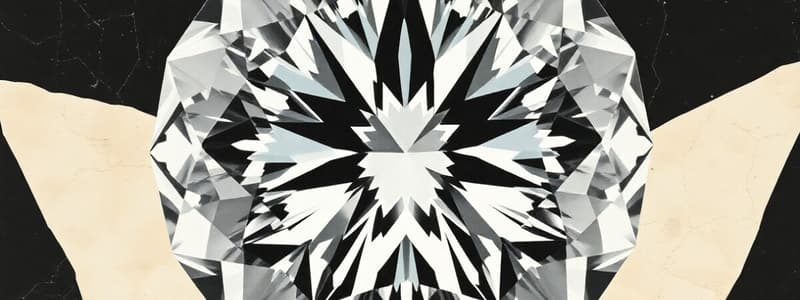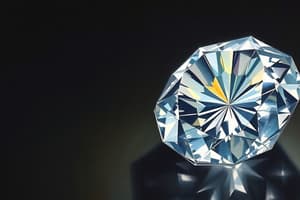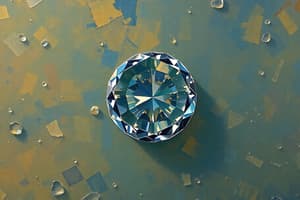Podcast
Questions and Answers
What should be checked to assess the girdle's thickness and condition in a bezel setting?
What should be checked to assess the girdle's thickness and condition in a bezel setting?
- Observe the prongs’ alignment.
- Check its reflection in the pavilion. (correct)
- Inspect the girdle’s color and clarity.
- Measure the distance from the table to the culet.
How can total depth percentage be determined for a mounted stone?
How can total depth percentage be determined for a mounted stone?
- By calculating the average between the upper and lower facets.
- By measuring from the table to the girdle.
- By getting the measuring device to contact the diamond’s culet. (correct)
- By estimating based on the stone's girdle thickness.
Which factor has the greatest effect on estimated weight of a diamond?
Which factor has the greatest effect on estimated weight of a diamond?
- Culet size.
- Crown height percentage.
- Girdle thickness. (correct)
- Pavilion depth percentage.
What must be assessed to judge pavilion depths and angles in mounted stones?
What must be assessed to judge pavilion depths and angles in mounted stones?
What adjustment is made for estimating the weight of diamonds with a thick girdle?
What adjustment is made for estimating the weight of diamonds with a thick girdle?
What is the primary goal of repolishing a diamond?
What is the primary goal of repolishing a diamond?
Which grade can a diamond considered a 'potential' achieve after repolishing?
Which grade can a diamond considered a 'potential' achieve after repolishing?
What factor is NOT considered when determining the value increase from clarity-improving repolishing?
What factor is NOT considered when determining the value increase from clarity-improving repolishing?
In the context of diamond recutting, what is the main purpose of adding extra facets?
In the context of diamond recutting, what is the main purpose of adding extra facets?
Which of the following processes does NOT involve altering the weight of a diamond?
Which of the following processes does NOT involve altering the weight of a diamond?
What is important to determine when estimating the weight of a round brilliant diamond?
What is important to determine when estimating the weight of a round brilliant diamond?
When estimating the weight of fancy cut diamonds, what dimensions are essential?
When estimating the weight of fancy cut diamonds, what dimensions are essential?
What adjustment factor is used for in diamond weight estimation formulas?
What adjustment factor is used for in diamond weight estimation formulas?
Which method is likely to improve the visibility of a diamond's clarity while mounted?
Which method is likely to improve the visibility of a diamond's clarity while mounted?
What is the primary reason a diamond owner typically prioritizes weight over beauty when considering recutting?
What is the primary reason a diamond owner typically prioritizes weight over beauty when considering recutting?
What is the primary reason a mounting can affect the assessment of a diamond's clarity?
What is the primary reason a mounting can affect the assessment of a diamond's clarity?
Which recutting technique is typically less expensive for improving diamond clarity?
Which recutting technique is typically less expensive for improving diamond clarity?
What grading approach is typically used for small mounted diamonds?
What grading approach is typically used for small mounted diamonds?
What is a significant risk associated with attempting to improve a diamond’s color through recutting?
What is a significant risk associated with attempting to improve a diamond’s color through recutting?
Which observation method is effective for evaluating a diamond's color when it is in a solitaire setting?
Which observation method is effective for evaluating a diamond's color when it is in a solitaire setting?
When estimating a mounted diamond's diameter, which part of the setting may obstruct accurate measurement?
When estimating a mounted diamond's diameter, which part of the setting may obstruct accurate measurement?
What type of diamonds can typically be recut into modern brilliants without considerable loss in diameter?
What type of diamonds can typically be recut into modern brilliants without considerable loss in diameter?
For large mounted diamonds, how is the color grade typically assigned?
For large mounted diamonds, how is the color grade typically assigned?
How does the original cut influence the recutting style of a diamond?
How does the original cut influence the recutting style of a diamond?
Which recutting approach is commonly used to modernize diamonds with older cutting styles?
Which recutting approach is commonly used to modernize diamonds with older cutting styles?
What technique might help in viewing the area under a prong while grading a diamond's clarity?
What technique might help in viewing the area under a prong while grading a diamond's clarity?
What common feature do all diamonds that are ideal for recutting into modern brilliants share?
What common feature do all diamonds that are ideal for recutting into modern brilliants share?
What is a challenge faced when estimating the crown angle of a mounted diamond?
What is a challenge faced when estimating the crown angle of a mounted diamond?
What factor is often evaluated when deciding whether to recut a diamond?
What factor is often evaluated when deciding whether to recut a diamond?
What impact does the metal of a mounting have on a diamond's appearance?
What impact does the metal of a mounting have on a diamond's appearance?
Which method is NOT recommended for measuring a mounted diamond's dimensions?
Which method is NOT recommended for measuring a mounted diamond's dimensions?
What is the most common purpose for recutting diamonds?
What is the most common purpose for recutting diamonds?
What is one disadvantage of recutting a diamond with shallow crown and pavilions?
What is one disadvantage of recutting a diamond with shallow crown and pavilions?
Flashcards
Weight estimation for round brilliant
Weight estimation for round brilliant
Estimating the weight of a round brilliant diamond requires knowing its diameter, depth, and girdle thickness in millimeters.
Weight estimation for prong-set diamonds
Weight estimation for prong-set diamonds
Measure the diameter of the girdle at multiple points between the prongs to determine the average diameter for weight calculations.
Weight estimation for fancy cuts
Weight estimation for fancy cuts
Estimating the weight of fancy-cut diamonds requires knowing the length and width of the stone.
Diamond Repolishing
Diamond Repolishing
Signup and view all the flashcards
Clarity-improving repolishing
Clarity-improving repolishing
Signup and view all the flashcards
Cluster diamond weight
Cluster diamond weight
Signup and view all the flashcards
Repolishing purpose
Repolishing purpose
Signup and view all the flashcards
Girdle Influence
Girdle Influence
Signup and view all the flashcards
Diamond Recutting
Diamond Recutting
Signup and view all the flashcards
Recutting for Clarity
Recutting for Clarity
Signup and view all the flashcards
Recutting for Color
Recutting for Color
Signup and view all the flashcards
Recutting for Style
Recutting for Style
Signup and view all the flashcards
Weight vs. Beauty
Weight vs. Beauty
Signup and view all the flashcards
Modern Brilliants
Modern Brilliants
Signup and view all the flashcards
Old Style Cuts
Old Style Cuts
Signup and view all the flashcards
Round or Near-Round Recuts
Round or Near-Round Recuts
Signup and view all the flashcards
High Crowns/Deep Pavilions
High Crowns/Deep Pavilions
Signup and view all the flashcards
Shallow Crowns/Deep Pavilions
Shallow Crowns/Deep Pavilions
Signup and view all the flashcards
Mounted Diamond Weight
Mounted Diamond Weight
Signup and view all the flashcards
Clarity in Mounted Diamonds
Clarity in Mounted Diamonds
Signup and view all the flashcards
Clarity Evaluation Techniques
Clarity Evaluation Techniques
Signup and view all the flashcards
Mounted Diamond Color
Mounted Diamond Color
Signup and view all the flashcards
Mounted Diamond Measurement
Mounted Diamond Measurement
Signup and view all the flashcards
Estimating Crown Angle
Estimating Crown Angle
Signup and view all the flashcards
Mounted Diamond Clarity Range
Mounted Diamond Clarity Range
Signup and view all the flashcards
Mounted Diamond Color Range
Mounted Diamond Color Range
Signup and view all the flashcards
Girdle Influence on Repolishing
Girdle Influence on Repolishing
Signup and view all the flashcards
Crown Height Percentage
Crown Height Percentage
Signup and view all the flashcards
Girdle Thickness
Girdle Thickness
Signup and view all the flashcards
Pavilion Depth
Pavilion Depth
Signup and view all the flashcards
Weight Correction Factors
Weight Correction Factors
Signup and view all the flashcards
Weight Estimation for Fancy-Cut Diamonds
Weight Estimation for Fancy-Cut Diamonds
Signup and view all the flashcards
Study Notes
Grading Mounted Diamonds
- Mounting a diamond makes assessing its characteristics difficult, as it hides parts of the stone.
- Fiber-optic lighting systems aid in prong inspection by reflecting light.
- Clarity grades for large diamonds are often presented as a singular grade, while small diamonds may have a range of two grades.
- Color evaluation uses a method for D-to-Z color range diamonds. One approach involves holding the diamond in a table-down position, moving along masterstones. Another involves holding both the mounted stone and masterstone side-by-side for face-up comparisons.
- Metal can impact a diamond's apparent color.
- Determining dimensions with a millimeter gauge is possible if the mounting allows access to the girdle. Estimating girdle dimensions is necessary when parts are covered.
- Crown angle estimation is often easier with a face-up method, using table percentage and crown angle charts.
- Girdle thickness is assessed by observing visible areas & those hidden by prongs.
- Pavilion depth estimations work the same for loose and mounted stones, by using reflections to evaluate hidden areas.
- Total depth percentages are determined by subtracting crown height & pavilion depth percentages
Estimating Diamond Weight
- Professionals use formulas to calculate mounted diamond weights—these formulas consider proportions.
- Accurate weight estimation relies on experience with practice.
- Girdle thickness significantly affects estimated weight.
- Weight correction charts apply to round and fancy-shape diamonds with thicker girdles.
- Diamond shapes (including fancy cuts) need weight corrections, which range from 1%-12% affecting the estimations. Specific factors include differences in pavilion bulge, high shoulders, or bulged wings of the diamond's facets.
- For round brilliants, weight estimation is dependent on the average diameter, depth, and overall girdle thickness.
- Calculating weight for fancy cuts uses length, width, and length to width ratio calculations to estimate via formulas.
- Clustered diamond weight estimation is obtained by measuring each stone, categorizing by size, and summing the category totals.
Repolishing and Recutting
- Repolishing involves refinishing to resolve clarity and finish issues.
- Some diamonds may benefit from additional facets to correct imperfections.
- Repolishing may improve a diamond's clarity grade.
- Repolishing or faceting the girdle can smooth the surface and potentially affect the diamond's color.
- Full recutting involves resetting a diamond to improve clarity, proportions, or color—or to update older styles.
- Recuts aim to compromise weight and aesthetics due to cost.
- Recutting might involve adjusting brightness, fire balance , or potentially color by recutting to improve color.
- Recutting may be used to address inclusion/clarity issues, in which laser drilling or bleaching techniques are options.
- Diamonds are sometimes recut to update old cutting styles
Studying That Suits You
Use AI to generate personalized quizzes and flashcards to suit your learning preferences.




